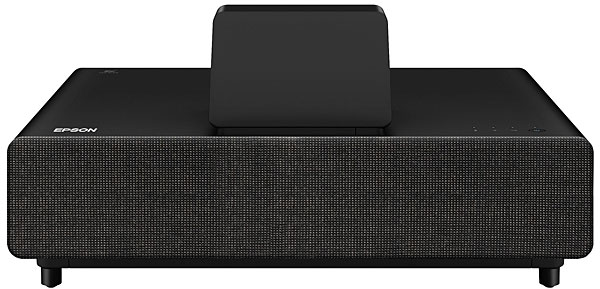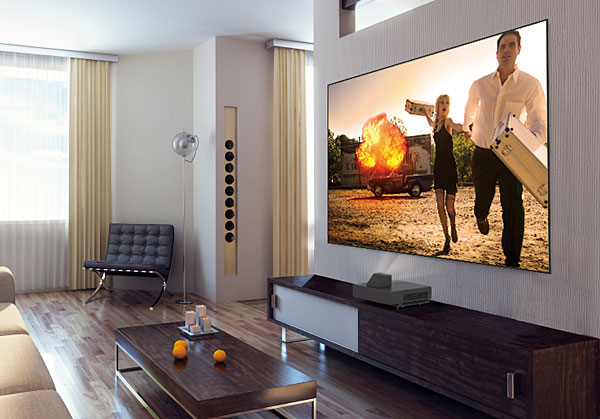Epson LS500 4K Laser Projection TV Review Page 2
I also created and stored memories for dark room viewing of HD/standard dynamic range and 4K/high dynamic range movies, using the projector's extensive settings to calibrate color/grayscale, and gamma. Calibrated light output in HD/SDR mode was 21.5 ft-L—sufficiently bright for viewing in a dim or dark environment—while the LS500's measured full-on/full-off contrast ratio 1,413:1 with Eco Light Output selected, and 1,830:1 in Normal mode.
I did note some HDR issues when watching programs via Android TV. While the included dongle does support 4K/HDR streaming from Netflix and YouTube, and will shift into HDR display mode when Auto mode is selected in the relevant menu, regular HD/SDR programs also sometimes registered as 4K/HDR. I did not experience the same problem with regular and Ultra HD Blu-ray disc playback, and when I swapped out the Android dongle with a Roku Streaming Stick+, all programs were displayed in the proper format by the LS500.
Performance
Viewing in daylight conditions, TV shows like Schitt's Creek looked crisp, clean, and bright—the LS500 is definitely more powerful than most other UST projectors I've tested when it comes to light output. While many similar models are marketed as an alternative for a flat-panel TV, Epson's could actually serve as the main screen in a typical well-lit living room.

Epson says that one of the main applications it had in mind for the LS500 is sports viewing, and while my current lack of a cable TV subscription (I'm a longtime cord-cutter) prevented me from watching NFL football, I did check out some highlights of that other, international football version, queueing up a replay of a Manchester United vs. Chelsea match on the Peackock TV app. Even viewed in a well-lit room with overhead lights on, the image was impressively bright and detailed, with crisp onscreen graphics. The red and blue uniforms of the Man United and Chelsea players, and the green turf they played on, came across as fairly well-saturated, and the white mesh of the goal nets had a solid look.
Switching over to dark room viewing, I fetched my copy of The Elephant Man. I'd been eagerly awaiting the arrival of this film on Blu-ray, and the Criterion Collection's version, which was created from a new 4K transfer, proved well worth the wait. While Epson's regular 3LCD projector lineup can be counted on to deliver images with powerful contrast—especially its "Ultra Black" models, like the Home Cinema 5050UB we reviewed in the August/September 2019 issue of Sound & Vision—the LS500's contrast capability is more modest. As a result, deep shadows in The Elephant Man came up short of true black, and letterbox bars were displayed as a dark gray tone. Even so, the Epson's image revealed an impressively wide range of grays in the film's black-and-white cinematography, and highlights were finely rendered. Picture uniformity was also excellent, with no sign of tinting anywhere across the screen to spoil the pristine monochrome images.
Switching over to Ultra HD Blu-ray viewing, the projector's HDR10 Setting adjustment let me easily optimize the PQ curve for transfers with varying levels of HDR intensity, including the very bright The Meg and the considerably darker 2001: A Space Odyssey. Post-adjustment, in a scene from The Meg where Jonas (Jason Statham) is sent out to tag the monster-shark with a tracking device, clouds looked detailed and the shimmer of light on the ocean had a decent level of brilliance. Watching 2001, the cave scene early in the film showed good shadow detail, though blacks lacked depth as expected. And in the subsequent space ballet scene (set to Strauss's The Blue Danube), I noted good highlight detail on the spaceships, while the starfields beyond appeared relatively punchy.
Unlike the 5050UB model I mentioned, the LS500 is not spec'd for P3 color space coverage and only managed 87.2 percent Rec. 709 color coverage in my measurements. Even so, the psychedelic sky in the scene from Guardians of the Galaxy Vol. 2 where Gamora sits quietly in a field before her respite is interrupted by an aerial attack from her sister came across as satisfyingly vivid, as did Gamora's green skin. The picture here also looked notably crisp—something that could also be said for all discs I watched with the LS500.

The Epson's built-in audio system delivered clear dialogue at a modest volume level, although there was a "boxed-in" quality to the sound, along with audible distortion when the volume was pushed to a medium level or beyond. This was especially the case when watching movies with effects-heavy soundtracks. I noted no lip-synch issues when I used my disc player's bitstream audio output, however, and the same was the case with both the Android TV and Roku streamers. Since the LS500 has an HDMI port with ARC support, I would recommend using that feature to feed audio to an outboard system or soundbar.
Conclusion
With its EpiqVision Ultra LS500, Epson has created a compelling all-in-one package that delivers a bigscreen image in a small space, and doesn't necessarily require a dark room for good performance. And at $4,999 with an included 100-inch ALR screen, it represents a very good value compared with its UST competition. The LS500's extensive picture settings and ability to be adjusted for various HDR sources also make it a standout performer in the UST arena.
As a dark room-inhabiting, cinephile type, for me the Epson's main shortcomings were its limited contrast ratio and remote control, which is clearly designed for general-purpose use, as opposed to obsessive on-the-fly image tweaking. Epson's included Android TV dongle also proved glitchy with HDR content, although that situation in my case was remedied by swapping in an inexpensive Roku streaming stick. But even with those few caveats, I found that Epson's LS500 more delivers more successfully on the promise of UST projection as an affordable alternative to massive flat-panel TVs than any similar model I've yet reviewed.




























































